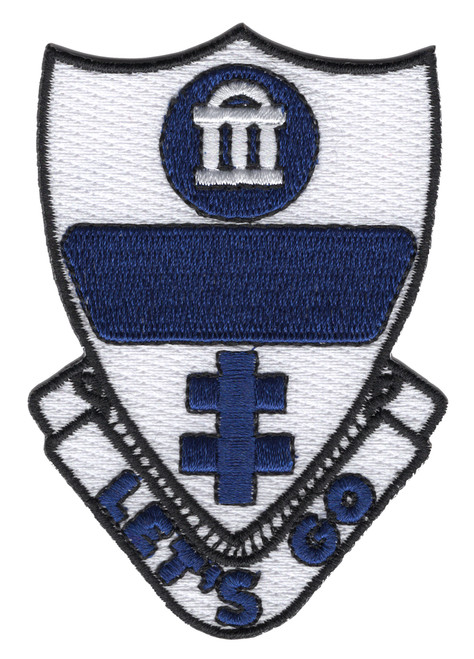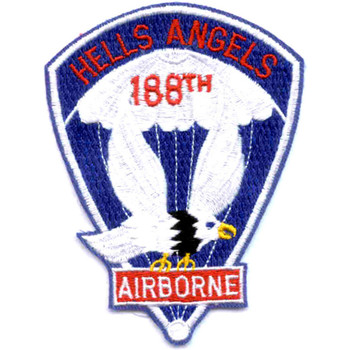Description
325th Airborne Infantry Regiment Patch (U.S. Navy) 2.5" x 3.5" Embroidered Patch with Iron-On Backing
Superior Materials: Made with premium polyester thread and durable twill fabric, ensuring long-lasting color and strength.
Advanced Embroidery Technology: Crafted using the most advanced embroidery machinery, guaranteeing intricate detail, sharp lines, and consistent quality every time.
Easy Iron-On Application: Features a heat-activated adhesive backing for quick, no-sew attachment. Simply position, iron, and press for a secure bond.
Versatile Use: Perfect for personalizing jackets, backpacks, uniforms, or any fabric surface that needs a touch of personality.
Durable and Washable: Designed to withstand everyday wear and occasional washing without fading or fraying.
Formations & Origins
The 325th Airborne Infantry Regiment has a lineage that stretches back to the First World War. Originally constituted on August 5, 1917, as the 325th Infantry Regiment, it was assigned to the 82nd Division and fought in the Meuse-Argonne Offensive. But it was World War II that transformed the unit's identity and set it on the path to becoming one of the Army’s elite airborne regiments. In 1942, as the United States built its airborne capability, the 325th was restructured as the 325th Glider Infantry Regiment. This move aligned it with the new strategy of vertical envelopment—fighting forces inserted behind enemy lines by parachute or glider.
Flying into battle without engines, armor, or second chances, the 325th Glider Infantry Regiment landed in Normandy shortly after D-Day and quickly distinguished itself in the hedgerow battles that followed. It was there, in the mud and hedges of France, and later in the freezing woods of Belgium, that the regiment earned its reputation for tenacity and close-combat skill. After the war, as glider operations were phased out, the unit was converted to a full airborne regiment.
During the Vietnam War, the 325th did not deploy as a full unit. Instead, it was kept in strategic reserve as part of the XVIII Airborne Corps’ rapid response force. While other airborne units from the 82nd, such as the 504th and 508th, deployed to Vietnam as part of the 3rd Brigade, the 325th remained stateside but maintained a combat-ready posture, capable of deploying anywhere in the world within hours.
The patch associated with the 325th is the classic “AA” (All American) insignia of the 82nd Airborne Division, worn beneath the airborne tab. While it doesn't have a unique patch exclusive to the regiment, its identity is unmistakably airborne, with the number 325 etched deeply into the culture of the division.
Notable Commanders
Leadership has always been a defining feature of the 325th. During World War II, Colonel Harry L. Lewis commanded the regiment with distinction during some of its most brutal campaigns, including the liberation of France and the defense of Belgium during the Battle of the Bulge. His calm under fire and aggressive combat tactics earned him the Distinguished Service Cross and the respect of the airborne community.
In the Cold War and Vietnam era, the 325th’s commanders focused less on battlefield maneuvers and more on maintaining high readiness under Strategic Army Corps (STRAC) alert standards. These leaders weren’t earning decorations in jungles, but they were building a force that could deploy to Berlin, Cuba, or Vietnam at a moment’s notice. Their job was to keep the 325th sharp, lethal, and mobile—ready to jump at H-Minus.
Major Campaigns/Operations
The 325th’s most famous combat actions occurred during World War II. In Normandy, they arrived via glider after D-Day and pushed through the German defenses in the hedgerows. During Operation Market Garden, they landed in Holland and engaged in house-to-house fighting to secure the bridges at Nijmegen. At the Battle of the Bulge, they were rushed north and fought to hold the line during some of the coldest, most desperate fighting of the war.
Although the regiment didn’t deploy to Vietnam, it played a crucial strategic role during that era. It remained on constant alert, ready to jump into Vietnam or any other global hotspot if the political situation escalated. This position was no less serious than combat—it meant training constantly, maintaining combat loads, and being able to respond to national command authority orders at a moment’s notice.
In the years that followed Vietnam, the 325th saw combat in Operation Urgent Fury in Grenada, where its paratroopers executed a combat jump and seized key objectives. In Panama during Operation Just Cause, the regiment again saw combat, securing strategic targets and conducting airfield seizures. During Operations Desert Storm, Iraqi Freedom, and Enduring Freedom, the regiment returned to the forefront of American combat power.
Specialized Role/Equipment
The 325th has always been a light, fast-moving airborne infantry regiment. In the Vietnam era, it trained intensively for rapid global deployment by parachute insertion. While Vietnam’s terrain made parachute operations rare, the 325th remained dedicated to mastering this method of assault. Its role was to seize airfields, key terrain, or strategic chokepoints ahead of conventional forces.
Its soldiers carried the standard loadout for the time: M16 rifles, M60 machine guns, M79 grenade launchers, and claymore mines. They trained in anti-ambush drills, close-quarters battle, and long-range patrolling. Equipment was kept light for mobility, and airborne soldiers learned to fight with what they could carry on their backs.
What truly distinguished the 325th was not its gear, but its ethos. The airborne culture demanded physical toughness, discipline, mental sharpness, and an unshakable will to close with the enemy under the worst conditions. Whether training in the pine forests of Fort Bragg or standing alert for a possible jump into Laos, the 325th upheld that standard.
Acts of Heroism
Though it did not deploy to Vietnam, the 325th’s history is rich with heroism. In World War II, Staff Sergeant Curtis Shoup was posthumously awarded the Medal of Honor for his actions during the Battle of the Bulge. Shoup, under heavy machine gun fire, charged an enemy position and destroyed it with hand grenades before being mortally wounded. His sacrifice saved his company and became a symbol of the regiment’s fearless character.
In Grenada in 1983, the 2nd Battalion, 325th executed one of the first large-scale combat parachute drops since World War II. Despite facing confusion on the drop zones and unexpected resistance, they adapted quickly, secured their objectives, and fought off enemy counterattacks. These actions earned the regiment the Arrowhead Device for spearheading an assault landing.
In Iraq and Afghanistan, soldiers of the 325th earned Bronze Stars with Valor, Silver Stars, and Purple Hearts for their actions in close-quarters battle, ambushes, and raids across hostile terrain. The regiment has always had a reputation for fighting above its weight and achieving results through grit and speed.
Legacy & Notable Achievements
The 325th Airborne Infantry Regiment stands among the Army’s elite. Its legacy includes participation in nearly every major airborne operation conducted by the United States since 1943. Though it did not directly fight in Vietnam, its strategic role as a global responder was vital. Its airborne standards shaped generations of soldiers and helped preserve American rapid deployment capability throughout the Cold War.
Today, the regiment continues to serve with the 82nd Airborne Division at Fort Liberty. Both of its active battalions—1st and 2nd—remain at the tip of America’s spear. The number 325 carries weight in airborne circles. It means you are ready to fight with nothing but what’s on your back. It means you are trusted to jump into chaos and bring order.
The H-Minus spirit—ready before the war even starts—is not a relic of World War II. It is alive in every trooper who walks into the hangar with a parachute on his back, waiting to load up, green light flashing, ready to be the first boots on the ground.






